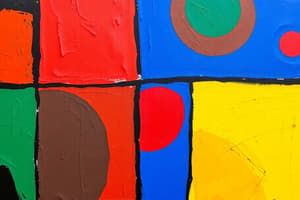Podcast
Questions and Answers
Art can only refer to specific types of works like paintings or sculptures.
Art can only refer to specific types of works like paintings or sculptures.
False (B)
Cultural diversity plays a significant role in understanding art and its purposes.
Cultural diversity plays a significant role in understanding art and its purposes.
True (A)
The term 'art' has a universally fixed meaning across all cultures.
The term 'art' has a universally fixed meaning across all cultures.
False (B)
Sociologists focus primarily on the aesthetic qualities of art rather than its social functions.
Sociologists focus primarily on the aesthetic qualities of art rather than its social functions.
Understanding art requires examining the variety of individuals and groups involved in its processes.
Understanding art requires examining the variety of individuals and groups involved in its processes.
Becker argues that art is solely the creation of artists without the influence of patrons or audiences.
Becker argues that art is solely the creation of artists without the influence of patrons or audiences.
The ownership of art has been linked to social status since the Renaissance.
The ownership of art has been linked to social status since the Renaissance.
Art-related cultural participation can lead to increased power and prestige.
Art-related cultural participation can lead to increased power and prestige.
Cultural capital has no significant impact on how art is consumed across different societies.
Cultural capital has no significant impact on how art is consumed across different societies.
The roles of artists and patrons are uniform across all cultures and subcultures.
The roles of artists and patrons are uniform across all cultures and subcultures.
According to Blau (1988), art is defined by societal institutions.
According to Blau (1988), art is defined by societal institutions.
Wolff (1981) asserts that individual artists solely create art through divine inspiration.
Wolff (1981) asserts that individual artists solely create art through divine inspiration.
Vasquez (1973) claims that market influences do not affect an artist's work.
Vasquez (1973) claims that market influences do not affect an artist's work.
Art educators should ignore the political and ideological contexts of art.
Art educators should ignore the political and ideological contexts of art.
Aesthetic enjoyment is viewed as entirely independent from social influences.
Aesthetic enjoyment is viewed as entirely independent from social influences.
Art serves eight general functions as identified by Dissanayake.
Art serves eight general functions as identified by Dissanayake.
Art only reflects the emotional power of reality without any therapeutic benefits.
Art only reflects the emotional power of reality without any therapeutic benefits.
The role of art in cultural imperialism has been studied by several researchers including Lukacs and Dubin.
The role of art in cultural imperialism has been studied by several researchers including Lukacs and Dubin.
Art is solely a personal experience and does not serve any communal functions.
Art is solely a personal experience and does not serve any communal functions.
Art has been described as essential for preparing individuals for life's challenges.
Art has been described as essential for preparing individuals for life's challenges.
Flashcards
What constitutes good art?
What constitutes good art?
This question explores the criteria used to judge the quality of art and whether it is subjective or objective.
Art as a process
Art as a process
Art can refer to the methods and techniques used to create a work of art, not just the finished product.
Culture-bound art
Culture-bound art
Our understanding and appreciation of art is influenced by our cultural background and experiences.
Unity in pluralism
Unity in pluralism
Signup and view all the flashcards
Social functions of art
Social functions of art
Signup and view all the flashcards
Social Construction of Art
Social Construction of Art
Signup and view all the flashcards
Art as a System of Signification
Art as a System of Signification
Signup and view all the flashcards
Influence on Artistic Creativity
Influence on Artistic Creativity
Signup and view all the flashcards
Artist's Role in Art Production
Artist's Role in Art Production
Signup and view all the flashcards
Art Education's Role
Art Education's Role
Signup and view all the flashcards
Art as a Social Process
Art as a Social Process
Signup and view all the flashcards
Becker's Definition of Art
Becker's Definition of Art
Signup and view all the flashcards
Art as a Social Status Symbol
Art as a Social Status Symbol
Signup and view all the flashcards
Cultural Capital
Cultural Capital
Signup and view all the flashcards
Art's Role in Culture
Art's Role in Culture
Signup and view all the flashcards
Art's Reflection of Nature
Art's Reflection of Nature
Signup and view all the flashcards
Therapeutic Role of Art
Therapeutic Role of Art
Signup and view all the flashcards
Art and Direct Experience
Art and Direct Experience
Signup and view all the flashcards
Art as a Reality Trainer
Art as a Reality Trainer
Signup and view all the flashcards
Art's Orderly Function
Art's Orderly Function
Signup and view all the flashcards
Study Notes
What Is Art For?
- Art serves many purposes across cultures, including representing cultural values, promoting continuity, and facilitating change.
- Questions about art's purpose are culturally-bound.
- The meaning of "art" itself varies across cultures.
- Art functions for gnoseological (spiritual knowledge), hedonistic (pleasure), and recreational purposes.
- Art can be used to express social status, commemorate events and people, record history, or express personal/cultural values.
- Art plays a role in cultural identity, social cohesion, and social change.
- There are many people involved in the production of a work of art, including the artist, patrons, and audiences.
- Aesthetics, art criticism, art history and art production are all critical disciplines in studying art.
- Art in some cultures is seen as a repository of cultural meaning, a system of signification, and can be used to create a shared cultural identity.
- Different cultural groups use art for varied purposes including celebrating events, teaching history, expressing emotions or telling stories.
- It is important to acknowledge diversity in art when teaching and studying art, avoiding ethnocentric views and appreciating the cultural contexts.
Three Approaches to Understanding the Purpose of Art
- Art reflects the natural world and is a source of meaning.
- Art is therapeutic and can be used to express and understand complex emotions.
- Art creates a sense of community and shared experiences.
- Art can be used to challenge cultural norms and promote social change.
- Art can provide a source of pleasure, beauty, and inspiration.
- Art can serve to record history, tell stories, and pass on cultural knowledge.
Studying That Suits You
Use AI to generate personalized quizzes and flashcards to suit your learning preferences.




